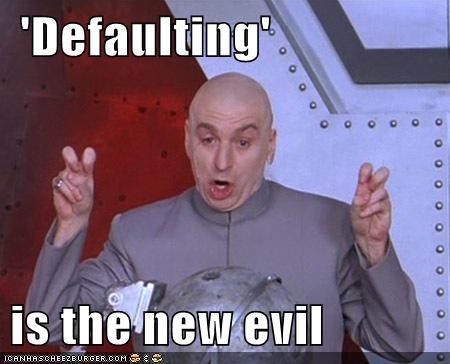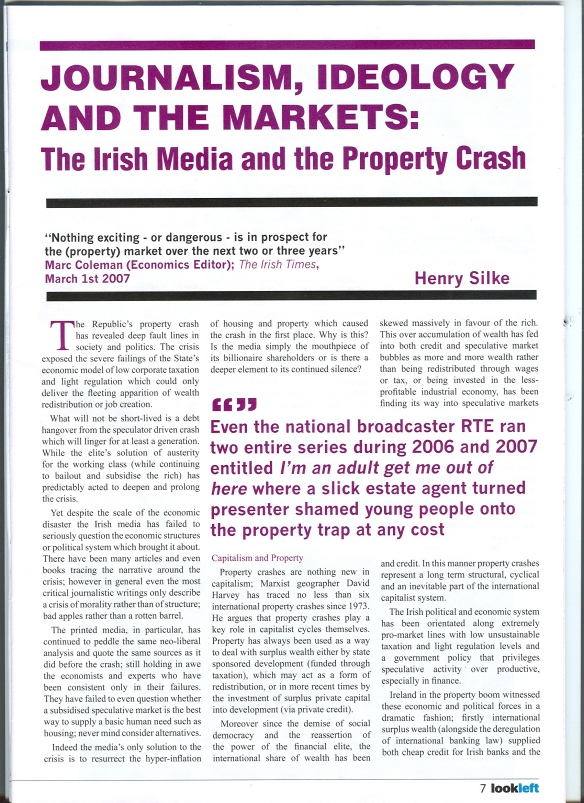Pat Kenny (on evictions) – ‘Will we see more people on the side of the road literally, soon?’
IBEC economist – ‘Look, I think all the options will have to be looked at’
Prime Time (RTE Current Affairs) 4th April 2013
Introduction
Ideology in its popular sense is seen as something akin to identity and something we are very much aware of, one has an ideological political position, usually some ‘ism’ or other. While true to a small extent the real secret of Ideology is the insidious nature of what becomes ‘common sense’, and how this ‘common sense’ may go on the frame narratives, agenda and discussion. This ‘common sense’ may or may not have any basis in material reality and it may or may not reflect an overt political movement. But scratch the surface and there is inevitably some class interests at stake. If one thinks of the inevitability of cuts as opposed to the impossibility higher corporation or wealth taxes as expressed by the mass media we can see that point.
In fact the entire notion of austerity itself is an ideological and class based construct, and yes, thus far, it is working very well for elite power. The ideology of austerity has become a default and assumed reality across much of the political spectrum. The only remaining questions being sectional and localised.
Within the mass media there is a tendency for dominant political and social ideas to become ‘common sense’, in other words assumed to be true while anything contrary to this ‘common sense’ is deemed political, ideological and not rational. This type of thinking allows someone like Karl Deeter, a constant and deeply ideological champion of the Irish Property market system, to proclaim:
‘…that Flac and New Beginnings “have an ideological view of the world. I don’t’. “Maybe that makes me soulless but I believe my research is good. They can dismiss my research and rubbish it but what have they done? What research have they put together. They have done nothing. I am certainly not going to back down just because people disagree with me.”
In other words those who are in any way critical of the premises of the market system are ideological while those who support this system are, in their minds, entirely rational. In the upside down world of newspaper and media, treatment of property heterodoxy is ideological while orthodoxy – even after the collapse of the property market – remains the only truth. The depth of ideological thinking within the Irish media can be seen in that even now, five years after the event, there seems to be no conception of the possibility of supplying housing outside of an unregulated market system.
Preparing the Ground – Identify the Enemy
Anyone who was in Ireland as the economy collapsed could not have missed the public-sector/private sector ‘debate’; which in reality was a class offensive which prepared the ground for huge cuts in pay and conditions in both sectors. The public sector were framed as lazy and overpaid as well as ‘holding the country to ransom’; their unions as old fashioned and corrupt. The private sector worker for their part were lionised for their perceived self sacrifice. Of course few in the media actually spoke to private sector workers or even their representatives and tended to speak to either private sector owners, managers or human resource ‘experts’, (which often meant highly paid private consultants). When private sector workers became unemployed they could be either used as a weapon to attack other workers pay and conditions or denounced as dole scroungers. This also played into the equally ideological ‘common sense’ viewpoint that anything organised in the private sector was efficient and well run, while anything not privately run was inefficient with the logical conclusion that privatisation would be a preferred option. This was particularly ironic at the time because the bulk of the collapsed private banking system (and more importantly its debts) were on the road towards nationalisation.
While not proposing there was a media conspiracy around this period, certainly there were structural and deeply ideological issues in effect, which again were affected by material conditions, identities, the class nature of journalism and journalists, working practices and ownership and the power of advertising (especially property).
The New Enemy Within?
So the question is have we reached another such point? Are we witnessing the softening up of the population for repossessions, evictions and a new class offensive. Well first we have to meet our new national villain – step forward the ‘strategic defaulter’.

Step forward the new villain ‘the strategic defaulter’
When developing a new ideological offensive what better candidate than Colm McCarthy to step up to the plate: in a number of recent articles he discusses the idea of the ‘strategic defaulter’.
…it appears that some people who have gone into arrears have been choosing to do so, in the sense that they do not lack the financial capacity to make repayments on schedule. Some arrears can be termed ‘distressed arrears’, in the sense that the borrowers simply cannot pay, but others, so-called ‘strategic’ arrears, arise through borrowers choosing not to pay, presumably in the hope that some debt forgiveness scheme will ultimately emerge, or that they can cod the bank into believing that they are suffering genuine financial distress.
McCarthy (and much of the media) have been citing Gregory O’Connor from the National University of Ireland Maynooth:
Mr O’Connor reckons that these strategic defaulters constitute at least 35 per cent of the total, based on statistical studies of strategic default in the United States, where re-possession is easier for the lender. Despite the greater severity of the housing downturn in Ireland, there have been far fewer dwellings re-possessed, relative to the volume of arrears, than in the USA or the United Kingdom.
So there you have it no less than 35% of defaulters and arrears are from strategic defaulters who are choosing not to pay. McCarthy is citing a blog post by Gregory Connor of the National University of Maynooth on The Irish Economy. There are however some serious issues with this blog post which becomes evident even after a brief reading. In effect the blog post boils down to saying that in the US there is X amount of strategic defaulters, Ireland has had a worse crash, therefore there must be Y amount of strategic defaulters here. It is also an entirely market based approach concerned with market values and negative equity. By using a market based approach it focuses mainly on those who purchased property as an investment, while ignoring those who bought property as a home. Moreover, it doesn’t deal with the issue of what happens to debt after a default is ignored. Under Irish law even if the property is re-possessed and sold, the remainder is still owed by the borrower, (however unrealistic the opportunity of return). In an Irish Times article Gregory O’Connor discusses his thesis further with some remarkable and what could only be describe as ideological oversights:
The classic source of distressed arrears is loss of employment. A Central Bank sample study showed that 32 per cent of residential mortgage holders in serious arrears were unemployed, or had a mortgage co-payer who was unemployed. Unemployment does not explain the remaining 68 per cent of arrears cases.
Unemployment may not account for the other 68% of cases, but what about pay cuts, pension levies, universal social charges, household taxes, loss of hours for contract workers, full time work reduced to part time? Not to mention other issues such as the cost of fuel (for those in the commuter belts), the cost of childcare, medicine etc etc. In simple terms a couple who may have bought a house they could barely afford in 2006, can quite reasonably, after losing the 15-20% of their income, having children or becoming sick be unable to afford that mortgage today. And in structural terms what about the unsustainable inflation of housing cost from 4 times the average wage to twelve times in less than a decade?
O’Connor also cites recent legal decisions which may well have had an impact:
The legal block on repossessions arising from the 2009 Land Conveyancing Reform Act is another obvious potential driver of strategic arrears. Starting that same year, the financial regulator imposed the Code of Conduct on Mortgage Arrears, limiting banks’ ability to scrutinise arrears cases. Combined with troubled banks’ natural tendency towards “extend and pretend” on delinquent loans, this created a tempting environment for mortgage holders inclined towards strategic default.
While there is quite possibly merit in this argument again it ignores everything else that happened in 2009.
In other words O’Connor’s work is simply speculation and pretty poor speculation at that. What is of interest is how a purely speculative blog post can then be then quickly reproduced in the mass media as peer-reviewed scientific fact:
Recent surveys suggest that at least 35pc of those who are in mortgage arrears may be unwilling, rather than unable, to pay. This figure is based on statistical studies of strategic default in the United States, where re-possession is easier for the lender.
For his part McCarthy hammers home some anecdotal evidence:
There is anecdotal evidence from bankers that some people are meeting all sorts of payments (direct debits for utilities) and also clearing credit card balances monthly, while failing to meet mortgage repayments.
Where to begin with this? While one can go into arrears with a mortgage and hope to work one’sway back in the future, one cannot, for example, stop paying electricity and gas bills without facing immediate cut off and losing the ability to heat your home. Not to mention the fact people may raise the €200 or €300 for a bill, but not be able to raise the €1,500 for the mortgage payment. The fact that McCarthy’s banking friends see this as a great immorality says much about their mindset. Likewise not paying a credit card minimum rate sees massive interest payments follow.
I am not arguing that there are no so called ‘strategic defaulters’, there may well be, certainly the developer class has had no qualms about such issues. Within working people there may be some, and I do not see any particular moral issue with it. After all the property market was overpriced and working people through taxation and cutbacks have already paid for much of the default within the system. In fact ‘strategic defaulting’ if done at a collective level in the form of a mortgage strike would be a legitimate and probably very effective form of class struggle. The point of this article is to consider why is this becoming a household term. Does it form part of the new mood music of banks ‘getting tough’? Is it recognition that the short term strategies of the banks and state are running out of steam? In short, is it a softening up for repossessions and evictions? This is not to be conspiratorial about the media; but at certain times media framing can become so commonplace that it seeps into the consciousness as ‘common sense’, and once a group is effectively demonised, actions considered abominable a short time before is suddenly not only acceptable but expected and even demanded.

Henry Silke is a PhD candidate in the School of Communications, Dublin City University. For more blog articles on the media treatment of the property crash see here, here, here and see here for an article on the conceptual basis of the research.


 Henry Silke, of this parish, wrote a short paper for the newly founded
Henry Silke, of this parish, wrote a short paper for the newly founded 









